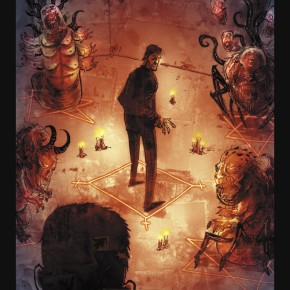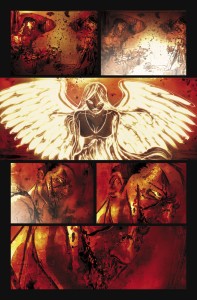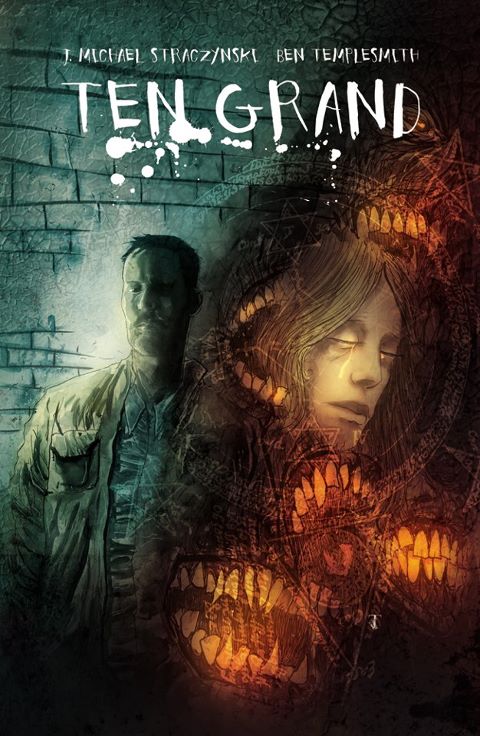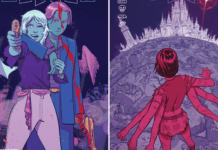And if you haven’t, I strongly recommend that you don’t read this full review, or maybe not even any of it, since not knowing anything about the comic before reading it makes for a pretty astonishing experience. TEN GRAND reads like a Choose Your Own Adventure story and you feel convinced somehow that you did choose all those twists and turns via the power of suggestion embedded in remarkable writing by J. Michael Straczynski and the disarmingly plausible world created by Ben Templesmith’s all-too-convincing artwork. The fact that it convinces you that you want to read a story that descends, and ascends such crazy distances is part of the allure, of course, and draws you into the life and times of main character Joe Fitzgerald. 
[*Spoilers start here]
TEN GRAND is several different types of stories in one. You’ve got the hard-boiled hit-man/detective feel which initiates you into Joe’s world as he meets potential clients in the seediest of seedy bars and decides whether to take their cases. The tropes don’t last long enough to make you feel you’ve read this story before, though, as Joe’s next case turns out to feature a cult. That somehow strikes home as being fairly relevant rather than being a plot device. There are plenty of crazy cults out there popping up from time to time in the media and plenty of missing young people families are searching for. It is, in fact, the world we live in. That helps establish some plausibility in TEN GRAND before things get really weird. Joe’s horror at the possibility that a man he thought he killed is actually now a cult leader is the turning point into a descent Dante would find familiar. Here you choose to follow him into that subterranean realm, against your instincts to stay in a familiar detective story formula.
There’s a particular parallel between the reader’s choice to descend like this and Joe’s own flashbacks of crossing that line in his own life, from operating in a fairly logical manner as a hired hitman, to discovering that there are more things in heaven and earth than are dreamt of in his philosophy, all turning on this same apparent cult leader. In this way the reader becomes a kind of mirror image of Joe’s psychology entering into unknown realms. 
It also becomes much more shocking in its contrasts between sentimentality and violence and it’s a credit to the book that it doesn’t desensitize you to violence before flashbacks to the gruesome deaths of Joe and Laura. By the end of the book you understand where Joe stands, a semi-damned man between heaven and hell, which has a backward flowing affect on how you viewed the seedy guy in the seedy bar at the beginning of the issue. Joe is both grotesque and infused with significance as a character, as a definitive underdog with an also fairly grotesque path of redemption looming. Joe’s position in the story is also reinforced by his chosen mission of dealing with his definitive nemesis, someone who blocked his way to earthly redemption in the first place. In Joe’s own words, things have gotten increasingly “personal” in a big way.
TEN GRAND is an exemplary framework for Ben Templesmith to stretch his own stylistic wings. He’s well versed in the sepulchral and underworld settings, as seen in the logical comparison to TEN GRAND, FELL, with Warren Ellis. But that’s not an accurate comparison because while Templesmith manages to infuse the most Hadean human underworlds with a sense of alluring energy, here he has full reign to explore the opposite, the gritty elements in the angelic.
While Laura is depicted radiating her own innocence and strength, Angels, also “enforcers”, like Joe, are at once beautiful and terrible as depicted by Templesmith. Their luminous eyes are fairly sinister, their wings have a disconcerting angle to them, and their absolute power over Joe’s fate is only accentuated by mandates delivered over Joe’s mangled, almost monstrously disfigured body. Apparently angels are bad asses, and both Straczynski and Templesmith agree on that. Templesmith’s visual characterization of Joe, contrasting his “normal” facial expressions and body language with the elevated, altered person he seems to become when dreaming or thinking of Laura is also a really effective strategy to suggest to the reader that Joe is the sum of disparate parts, someone for whom redemption is not impossible, but one who is not particularly close to that goal in daily life, either.
Reading TEN GRAND convinces you that you don’t really want predictable stories even if going off the beaten path means the occasional bout of vertigo. It’s simply solid storytelling, on one level, but on another, it goes much further than necessary to merely make a good comic, both in the realm of narrative and of artwork. 
Title: TEN GRAND: Blood Oath
Publisher: Image, Joe’s Comics, Studio JMS
Creative Team: J. Michael Straczynski, writer/Ben Templesmith, illustrator/Troy Peteri, letters.
Hannah Means-Shannon writes and blogs about comics for TRIP CITY and Sequart.org and is currently working on books about Neil Gaiman and Alan Moore for Sequart. She is @hannahmenzies on Twitter and hannahmenziesblog on WordPress.













Where it’s going? I can tell you that. JMS will probably jump off ship about 6 issues in, and then blame Ben Templesmith for all of the problems.
The memory of how pretentious, overwrought and trite The Twelve was is more than enough to extinguish any possible urge I might have to read any more of Straczynski’s work.
I found the first issue to be entertaining, and leave me wanting more. I like the direction of the series, in both writing and art…..I’m hoping against hope that JMS is in his “Amazing Spiderman” mindset, and not “Superman”.
I do find it interesting that JMS chose to go with Image rather than Vertigo.
So basically it’s a rehash of Hellblazer minus the brit smugness ;-)
Is it just me, or is it strange to name a protagonist after yourself?
Comments are closed.